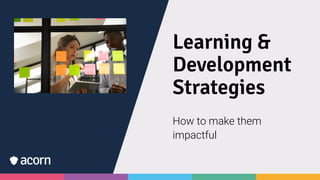
How to make your L&D strategies impactful
- 1. Learning & Development Strategies How to make them impactful
- 2. What is an L&D strategy? A learning and development (L&D) strategy outlines how an organisation uses employee training to develop workforce capabilities, competencies, knowledge and skills.
- 3. Why is one important? Only 40% of companies say their learning strategy is aligned with business goals. Being out of sync with business needs means learning can’t be truly effective – and even if it somehow is, you likely can’t retrace your steps to prove direct causation.
- 4. Making it truly effective A truly effective L&D strategy follows people strategy, which in turn takes its cues from business strategy. That means at any point in time, a solid L&D strategy should be systematically addressing high-level business needs like capability gaps.
- 6. Guided learning But it’s not just about upskilling anymore. Proactive and guided learning interventions are necessary for developing the capabilities essential to business success, so you have them when you need them.
- 8. 1) What are our business needs? L&D can’t be all things to all people. It should look at the bigger picture. Identify gaps in knowledge, skills and attitudes that are holding the company’s desires back from becoming reality. You can then develop training to address these gaps.
- 9. 2) What does an L&D plan look like? Prioritise the gaps, and therefore the training, that will have the biggest business impact. Consider starting with jobs that will be most affected by new technologies.
- 10. 3) What framework will we work in? Creating a framework for an L&D strategy gives a comprehensive foundation for the scope, purpose and activations. It also shapes the desired future state of your L&D function.
- 11. The 70/20/10 framework The 70/20/10 approach is perhaps the most well-covered approach in L&D literature. Its formula is as follows: • 70% of learning occurs in real life, on-the-job experiences. • 20% of learning comes from feedback and observation. • 10% comes from formal training, which usually forms a base of knowledge and skills.
- 12. The 70/20/10 framework While you don’t have to follow this to a tee (managers probably come closer to a 50/30/20 split), we mention it because as much as an L&D strategy should consider the learning element, you need to think about how professional development is contextualised and applied.
- 14. 1) Translate L&D ROI into business language Business leaders are looking for more strategically impactful metrics than just knowledge retention or time to proficiency. Therefore, you need to start talking about your L&D strategy in the financial and operational language of the business.
- 16. 2) Establish stakeholders in organisational L&D Ineffectively marketing L&D and its value is the pitfall to avoid here. You need not just the L&D team, but key roles across the business to advocate for L&D at every touchpoint. This includes business leaders, line managers, HR leaders, IT and even employees.
- 17. You can learn more about this topic by checking out the full article: https://acornlms.com/enterprise-learning- management/learning-and-development- strategy
